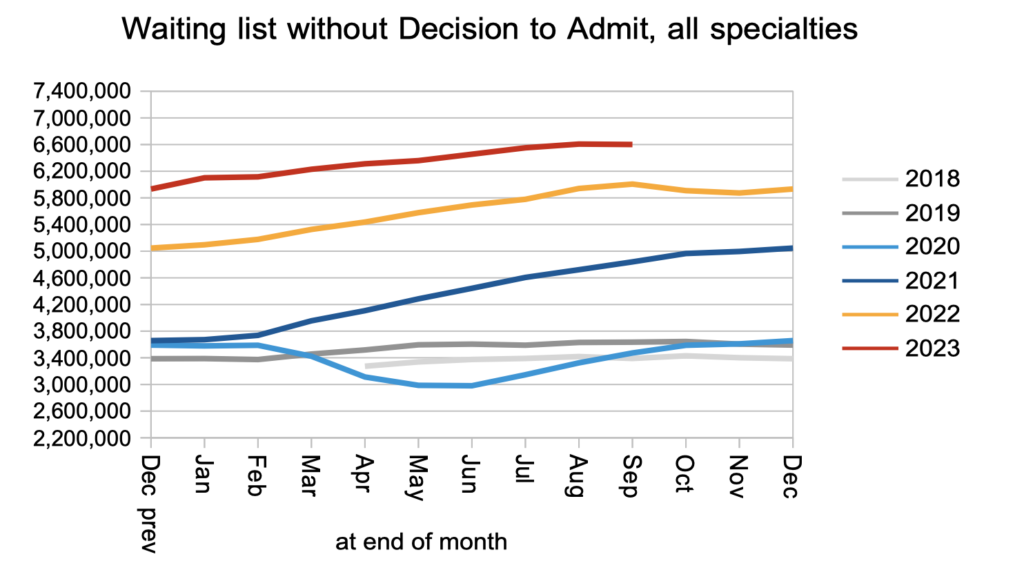
During the pandemic the bad years became awful years – the waiting list was going up like a rocket. But more recently there have been signs that this very rapid growth is finally slowing – so that the waiting list merely fails to shrink in the autumn, rather than ballooning regardless of the seasons.
Analysis produced for Health Service Journal by Dr Rob Findlay, Director of Strategic Solutions at Insource Ltd and founder of Gooroo Ltd
This is how the elective waiting list used to work before the pandemic:
“The national waiting list has a clear seasonal cycle. It grows strongly in the spring. And it falls decisively in the autumn.
“That’s what happens in a good year, anyway.
“In a bad year, it grows in the spring and plateaus in the autumn. So at the end of a bad year the waiting list (and waiting times) end up being much longer.”
It is in this context that September’s smaller-than-usual growth of 26,000 patient pathways should sit. It is better than the average growth of 100,000 per month that we saw in the three years up to July. But it is also true that the waiting list is terrible and getting worse. It just isn’t getting worse quite as rapidly.
In the following discussion, all figures come from NHS England. You can look up your trust and its prospects for achieving the current waiting time targets here.
The numbers
The figures quoted above include adjustments for non-reporting trusts; the charts below do not.
Patients joined the waiting list and started new waiting time ‘clocks’ at just above pre-pandemic rates, continuing the pattern of recent months.

Patients were discharged from outpatients, or otherwise removed from the waiting list without being admitted, at above pre-pandemic rates – again continuing the pattern of recent months.

The net effect of those joiners and leavers, together with those patients who received a decision to admit (who are not captured in the data), was that the number of patients waiting without a diagnosis and decision (i.e. most of them) remained steady. I estimate that they include some 28,000 patients whose eventual diagnosis will turn out to be cancer, after a typical wait for diagnosis and decision of 44.1 weeks.

The number of patients who were treated and discharged from the admitted patient waiting list remained slightly below pre-pandemic levels, which also continues the recent trend.

Looking at the whole referral-to-treatment (RTT) waiting list, it remained broadly steady during September, but – when the lone non-reporting trust is added back in – we find that the list grew by 26,000 patient pathways as noted at the top. The red triangle shows that, even if the shape of the waiting list improved to pre-pandemic levels, the waiting list is four million patient pathways too large to restore 18 week waiting times.

Waiting times remained steady, and far too long, in September.

Long waiting times are either caused by an excessively large waiting list (which we looked at above), or by some patients being treated faster than others (which the next chart examines), or both. We can see that the order in which patients were treated remained significantly worse than pre-pandemic, and the main driver of this at national level is the variation in waiting time pressures across different clinical services at different hospitals. And we saw above that the waiting list is far too big as well.

The waiting time pressures vary between one specialty and another at national level. Neurosurgery has the longest waits, elderly medicine has the shortest, and waits are generally shorter in medical specialties (which have high rates of clinically urgent patients and are predominantly outpatient-based) than they are in surgery.

Looking at the nearly three thousand local specialties at hospital providers across the country, we can see that the very longest waiting times have reduced over the last year in response to the targets, but otherwise waiting times remain very long, and much longer than the 18 week standard which is still a legal requirement.

Referral-to-treatment data up to the end of October is due out at 9:30am on Thursday 14th December.
